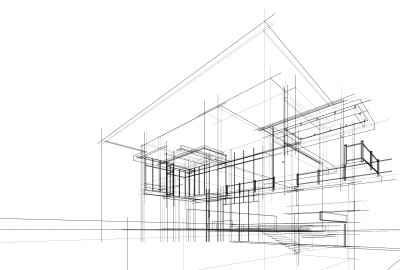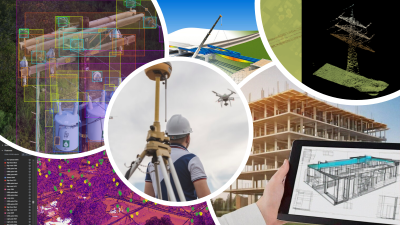As someone who is, at least relative to the general population, fairly tech-forward, watching this boom around artificial intelligence has been an interesting one to play out in real time. For one thing, many non-technical people conflate AI in general with specific generative AI tools, most notably ChatGPT. There’s also a basic misunderstanding of what this technology does from many in the mainstream, which has an interesting side effect of causing people on both extremes to overstate the positives and negatives with the technology. There’s little doubt that some industries and professionals can benefit greatly from these tools, and also that some industries and professionals have legitimate concerns that need to be considered as the tools become more pervasive across industry.
Today, I want to focus on one particular industry where generative AI is starting to pop up a little more as the tools become more sophisticated – AEC. Specifically, I want to talk a bit about generative AI in architecture for building design and model creation. This is an area that is still very much in its nascent stages, even in comparison to some other generative AI workflows, but one around which the industry is working to make real strides. Given the investment around anything to do with generative AI, it would be naive to think that these tools aren’t going to continue to grow in scope and influence. So, while at this point it’s still a niche, it’s worth considering some of the potential downsides that could come along with mass adoption.
Before diving into some of these potential issues, we should be clear that the idea of generative AI being incorporated into architectural workflows is not entirely negative. Even I, someone who is probably a bit more skeptical than the average person when it comes to generative AI in general, have used it. Geo Week News has used images generated by Shutterstock's AI platform – including the lead image for this article – and while I’ve never used ChatGPT for actual writing (and won’t) it has proved valuable for other parts of the writing process, such as brainstorming headline ideas.

Specifically around architecture, generative AI does have the potential to provide tangible benefits. For one thing, like many other industries around the world, architecture is dealing with a relative shortage of skilled workers, so anything that can step in to make work quicker helps deal with some of the knock-on effects of worker shortages. There’s also the potential for these tools to provide a collaborative “partner” with a different perspective by collecting perspectives from all of the data used to create the algorithm. A generative AI tool could also make it easier to quickly run through different ideas, particularly around utilizing a variety of materials and how that could affect designs.
That said, I think the industry needs to take very seriously the potential negatives these tools could bring into the sector if their implementation is not handled with care. First and foremost, that starts with a natural decrease in creativity. I find that generative AI enthusiasts sometimes have a tendency to talk out of both sides of their mouth, simultaneously talking up the potential for these tools to unthinkable degrees, while also saying they are simply a tool to be used by humans, who ultimately make decisions. As tools that can create designs and models become better, it will be easier for professionals to allow them to do more work, ultimately taking creativity out of an industry that desperately needs it.
That also dovetails into issues I can foresee around consequences for young workers who will be entering the industry over the next decade or so. As these tools become more mainstream, it will be a necessity in college training to become proficient in using them. Of course, every professor will warn against relying too much on these tools, but think back to when you were college-aged. Speaking for myself, I know I would only hear the parts about how this tool can do most of my work for me, and tune out the warnings. As a former math major I liken it to calculators – yes, most primary and secondary math can be done on a calculator, but it’s important to learn how to do these problems without it in order to understand the fundamentals. The same is true here, and if there’s not care taken around implementation the industry runs the risk of raising a generation lacking those crucial fundamentals.

A lot of AI-driven tools for design and model creation also boast how they can help make projects more environmentally friendly, and while it makes sense on the surface – these tools can quickly calculate how different design and material options change carbon emissions and other sustainability KPIs for a project – particularly with generative AI solutions I’d urge digging deeper.
Perhaps the biggest argument against generative AI in general is the amount of energy consumption it requires. It’s often said that creating a single image with generative AI requires the same energy as charging a smartphone. Broadening the scope a bit, in March Vox wrote, “If ChatGPT were integrated into the 9 billion searches done each day, the IEA says, the electricity demand would increase by 10 terawatt-hours a year — the amount consumed by about 1.5 million European Union residents.” It’s entirely possible that the energy savings brought on by these generative AI workflows more than cancel out any energy used to create designs and models, but it’s important that this consumption is at least part of the calculation.
These are only a few of the issues that need to be considered as generative AI tools for AEC, and specifically design, become more commonplace. Other issues, like data security and AI bias, need to be addressed as well, though that’s true for every industry.
Again, none of this is to say the industry should shun the technology entirely. That probably wouldn’t be possible even if it was advisable. The important takeaway is simply to use care as these tools become more common. Once a technology fully takes root, it’s incredibly difficult to change, which means the hard work needs to be done in the earliest stages possible.






